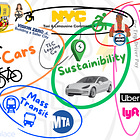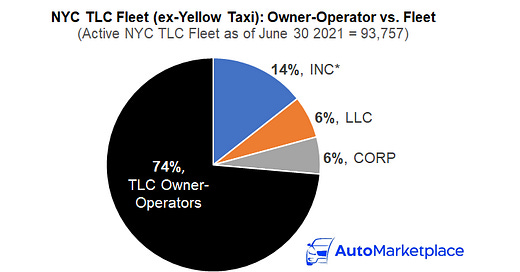

Discover more from AutoMarketplace
📋 NYTWA Unveils Plan to End Driver Lockouts with Clear Demands
New York Taxi Workers Alliance (NYTWA) announced a set of specific demands aimed at ending driver "lockouts." They are organizing a "march by foot" from City Hall to Uber's NYC HQ on Wed, July 17th
NYTWA lists specific demands that it says will end driver lockouts
Influential driver advocacy group also announced “march by foot" from City Hall to Uber's NYC HQ on Wednesday, July 17th at 1pm
OPINION: We agree with many demands, but drivers must note NYTWA’s taxi medallion sector bias
The New York Taxi Workers Alliance (NYTWA) listed specific demands in a publicly-shared flyer entitled “Stop Uber / Lyft Lockouts! Raise Our Pay!”. NYTWA also announced a second major strike action in relation to NYC TLC driver “lockouts”, or a situation where a driver cannot log into the Uber of Lyft app when and where they want.

🔍 Searchable Text Of NYTWA Flyer 👇
STOP UBER / LYFT LOCKOUTS!
RAISE OUR PAY!
Uber lockouts are costing drivers hundreds of dollars in income per week! Uber is also using lockouts to weaken TLC pay rules so Uber and Lyft can pay less to drivers for years to come! ONLY ACTION BY THOUSANDS OF DRIVERS CAN END THE CRISIS AND WIN A SOLUTION! Join on JULY 17th for UBER DRIVERS MARCH from City Hall to Uber’s NYC HQ and let Uber/Lyft/TLC know drivers are READY TO STRIKE! No cars. We march by foot to fill up the streets and be seen and heard!
WEDNESDAY, JULY 17th at 1PM
UBER & LYFT DRIVERS
READY TO STRIKE MARCH
FROM CITY HALL TO UBER HQ
Meet at 1PM at Broadway and Murray
March by foot from City Hall to Uber’s NYC Headquarters, 175 Greenwich St.
DEMANDS!
FIX UTILIZATION RULE TO STOP LOCKOUTS + RAISE OUR PAY! Uber wants to weaken the TLC rule so they can pay drivers less and are using lockouts to pressure drivers to give up this pay. THERE IS A SOLUTION: TLC uses the actual utilization rate to re-calculate our pay rates and reviews utilization every two years (not once a year.) Uber is locking out drivers now to make us look less empty when its utilization for 2024 is reviewed in Jan 2025. Our solution will stop drivers from losing income AND gives the companies an extra 12 months to improve their average. There would be no incentive for Uber / Lyft to continue lockouts.
STRENGTHEN FHV CAP. Limit new plates only to renters + only issue if utilization would not fall!
CAP FHV RENTAL AND FINANCING COSTS! TLC caps yellow cab leases, we need same protection for FHV drivers!
PASS CITY COUNCIL BILL TO STOP UNFAIR DEACTIVATIONS! Unfair deactivations and lockouts hurt drivers and let Uber/Lyft manipulate TLC pay rules!
Update TLC Pay Rule: Pay Drivers 85% of fare or 100% of TLC rates if higher + Double the rates on out-of-town trips!
****************************
Uber is blaming lockouts on TLC’s utilization rule which pays for empty time. But Uber and Lyft got the TLC utilization rule in 2023 that the companies wanted! Drivers are already been taking a loss of $5,000 - $7,000 per year because of the weaker rule. In exchange, Uber implied drivers could expect there would be no lockouts. Now, Uber is using lockouts o pressure TLC to make the rule even weaker and leave drivers with less pay! Our demands are the solution to end lockouts and raise our pay! JOIN JULY 17th!
****************************
NEW YORK TAXI WORKERS ALLIANCE
718-706-9892
31-10 37th Avenue, Suit 300, LIC, NY 11101
Article continues after advertisement
Did you know? Drivers enrolled in Drivers Benefits can receive up to $2K in dental services1 each year, plus many other valuable Health & Wellness benefits – all at NO COST to you!
Good Ideas, But Note Yellow Cab Bias
We think some of NYTWA’s demands are well thought out, while others reveal a “yellow cab” bias. There is nothing inherently wrong with having a taxi medallion industry bias, but we believe it’s always good to be transparent about biases, especially when drivers are putting their full trust in your advocacy.
For example, as we’ve disclosed several times, we run a NYC for-hire vehicle (FHV) leasing company. Some might think we have bias that tries to promote a certain TLC “leasing company” narrative. After all, we have a direct financial incentive to do so. That being said, if we’re not thoughtful with our opinions and perspectives, then people aren’t going to subscribe to our content and that’ll hit our media business and the traction AutoMarketplace gains. So, we also have a direct financial incentive to be mindful about our biases and present balanced opinions.
What NYTWA is not addressing is why it feels the yellow cab (“medallion”) sector can accept or reject Uber “e-hails” and not be subject to utilization rate (UR) and TLC minimum driver pay rules. This, in our opinion, is why NYTWA is not asking for the TLC to abandon UR as a regulatory metric, as we’ve been calling for.
Subjecting non-medallion “black car” TLC-plated vehicles to UR and minimum pay rules for high-volume (Uber or Lyft) dispatches, but not yellow cabs will directly incentivize Uber (and Lyft) to dispatch to taxis. This is in direct conflict with advocating for the best solution for app-focused NYC TLC drivers. However, we do agree with NYTWA’s call to have much more stringent control over new FHV License (TLC Plate) issuance, FHV “lease caps” and the process around protecting drivers from unfair Uber/Lyft deactivations.
As mentioned above and in previous articles, we do not agree with the continued use of UR as a regulatory metric because it solidifies Uber and Lyft’s duopoly grip. UR is also overkill when you have appropriate driver and vehicle license supply controls. We do not think NYTWA is gaming this out correctly.
For example, let’s say you start a new ridehailing app, it gains traction and it passes the 10,000 daily trip “high-volume” for-hire service (HVFHS) threshold. To be clear, if a new app can get to 10,000 daily trips in NYC, it would mean it has only gained less than 1.5% market share of all NYC for-hire trips (~800,000 legal daily NYC for-hire trips).
The TLC will then group that, let’s say 1.5% to 2% market share, company with Uber and Lyft. That much smaller company will need to abide by UR metrics (i.e., 53%+ utilization) and minimum pay rules, which will quickly put it out of business. If industrywide UR metrics effectively weights market shares for HV bases to come up with the “blended” industrywide average, then a smaller HV competitor may have a chance at competing/surviving. However, it’ll become so complex to try operate in that environment that we’re not sure how a small company (again, ~1.5% market share) would manage that.
Keeping UR solidifies Uber and Lyft’s duopoly grip on the NYC for-hire transportation market. Exempting yellow cabs from UR when they are e-hailed by Uber or Lyft is, in our opinion, why NYTWA wants to keep UR as part of the driver minimum pay formula for app drivers only. The taxi medallion sector benefits from that. We’re not saying Uber or Lyft are without fault, but it’s important to note that NYTWA also has its own, unique agenda. Our goal with this publication is to inform drivers, fleets, and other industry participants about different viewpoints—some of which are very technical and not always obvious—so people can make informed decisions about where they stand and what they want to support.
To be clear, we agree with some of NYTWA’s proposals, but beware of a very obvious taxi medallion sector bias. They need to disclose this to NYC TLC drivers, who mostly work for Uber and Lyft, when presenting their demands, or it can eventually be viewed as disingenuous.
If the TLC and NYTWA want to keep a UR-based NYC driver minimum pay formula, our suggestion would be to raise the HV daily trip threshold to 100,000 trips. This will allow more competition to enter the market and give drivers hope that more options will arise.
















Your accusations of NYTWA’s motives are simply wrong; and so is the position that utilization rate is not important for Uber and Lyft drivers. Your wrong position seems to stem from you evaluating the utilization rate from a business (anti-competitive) point of view – and not from the point of what is in the interest of Uber and Lyft drivers and their right to a dignified income.
1. Counting yellow cab trips as part of Uber’s utilization would artificially bring up the utilization rate for Uber - allowing Uber and Lyft to pay less to Uber and Lyft drivers, even though Uber and Lyft drivers were not getting more trips.
Yellow cab trips are dispatched via Curb and Arro. Drivers are not on the Uber app, so right now their "empty" time is not counted and does not bring down or up the Utilization Rate in the driver pay rules. Counting those trips would mean a credit for Uber’s utilization.
It is in Uber's interest to have yellow cab trips be credited for utilization. It would let Uber increase the amount of time Uber and Lyft drivers are considered occupied without adding to the time drivers are considered empty.
In other words - like lockouts - it would be another way for Uber and Lyft to have Uber and Lyft drivers appear less empty than they actually are.
Uber would get credit for when it dispatches to taxis and that would mean Uber could pay it's majority workforce (Uber and Lyft drivers) - to whom it dispatches 99% of the trips to and the drivers who are dependent wholly on Uber/Lyft trips - less income on each trip.
Meanwhile, as you reported yourself from the flex fare TLC hearing – Uber and other e-hail providers pay yellow cab drivers rates far below the meter on e-hail trips, making the trips poverty rates. NYTWA has called repeatedly for the regulation of e-hail trips, both before City Council and the TLC--most recently at the May 8th TLC hearing.
Letting Uber get credit for these low-paid trips would injure Uber and Lyft drivers and is an insult to yellow cab drivers.
2. Automarketplace's argument against Utilization is that a requirement to pay drivers for empty time is hard to do for a small company and so no new company will be able to compete against Uber.
That is an argument invested in protecting businesses - not protecting drivers and their right to a dignified income.
3. NYTWA is a labor organization. We answer only to the interests of the drivers. We have built a genuine platform of unity among drivers because that is the only way drivers can build real power and improve their lives.
The companies pitting drivers against each other is what lead to devastation. Uber starved the Uber driver to starve the yellow cab driver – flooding the streets with cars and then cutting rates. Drivers do not win when they are divided against each other. In this case, counting yellow cab trips so Uber can pay Uber drivers less, would mean letting Uber pay yellow cab drivers less than what they deserve and then use those trips to pay Uber drivers less than what they deserve. Those games are tired. Drivers have come too far to be divided or be left in poverty.
Maybe Automarketplace would be ok with Uber drivers taking the loss because you are fundamentally against the utilization rate since you see it as a burden for new companies. That’s the wrong position. Taking on Uber’s monopolization should not involve cheating Uber drivers out of income they deserve.
The only thing that Uber have to do is pay a little more